

Pediatric allergist traces 'mystery' reactions to pea protein — an increasingly popular ingredient. As a pediatric allergist, Dr.

Elana Lavine often advises parents to avoid peanuts, eggs and seafood. Now, she's warning them that allergies can also be triggered by "pea protein" found in a growing number of foods. Lavine described what happened to a two-year-old patient after eating non-dairy yogurt. "When given the yogurt, they had a full-blown anaphylactic reaction in the aisle of the grocery store," she said. The girl has an allergy to peanuts and tree nuts, but her parents had no idea what caused the yogurt reaction.
Neither did Lavine. Split peas are a type of field pea grown for drying. The protein, which is extracted and concentrated from peas, is popping up in all sorts of products on grocery store shelves, often as a substitute for meat protein. Lavine estimated 95 per cent of patients with peanut allergies can tolerate peas. Lavine was so concerned about the reactions her patients described, she wrote a case study about them in the Journal of Allergy and Clinical Immunology. Food Allergy vs. Food Intolerance: Why the Difference Matters. All too often, when patients claim to react poorly to certain foods but labs don’t show an allergy, their concerns are dismissed and they’re told, “It’s all in your head.”
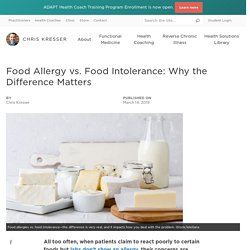
Although we have a lot to learn about food intolerances, ever-growing research proves that they aren’t psychological or make-believe. Read on to learn the differences between a true food allergy and a food intolerance, some examples of common food intolerances, and how healing your gut can, in some cases, alleviate the problem. Natural Ways to Treat Seasonal Allergy Symptoms. What makes spring so beautiful for many people leads to misery for those who suffer from seasonal allergy symptoms.

Natural allergy treatments can be as effective and, in many cases, more effective than allergy medications. Fresh cut grass, blooming trees and flowers, and weeds release pollen, causing seasonal allergies in an estimated 40 million to 60 million people each year. (1) Allergic rhinitis is the medical term for hay fever and seasonal allergies that occur not just in the spring, but throughout the summer and into the fall. (And did you know certain foods, even healthy ones, can make your allergies even worse? See the list of 18 foods below.) While hay fever frequently begins at a young age, it can strike anyone, at any time. Home. 6 Food Allergies Treatments and Natural Remedies. Despite the risk of severe allergic reactions and even death, there is no current cure for food allergies.
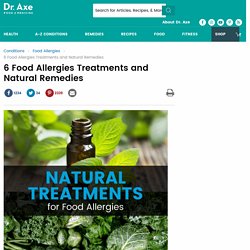
The condition can only be managed by allergen avoidance or treatment of food allergy symptoms. Milk Allergy + 7 Easy & Natural Ways to Manage It. Did you know that milk is one of the most common food allergens in existence?
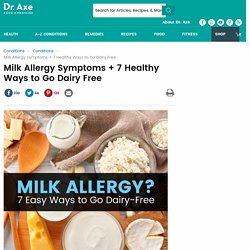
It’s estimated that between 2–3 percent of children under the age of 3 have a milk allergy. Experts used to think that these were just temporary baby allergies or infant allergies and kids would outgrow their dairy allergy once they were 3 years old. But research has shown this isn’t necessarily the case. Shellfish Allergy Symptoms, Effective Remedies & Alternatives. It’s true that with food allergies, one person’s food can truly be another one’s poison.
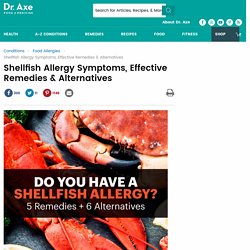
The popularity of shellfish has been increasing worldwide, but consequently, shellfish constitute the No. 1 cause of food allergies in the American adult. The approximate prevalence of shellfish allergy is estimated at 0.5 to 2.5 percent of the general population. (1) Cooling Inflammation: Bee Sting Allergy. Typical.
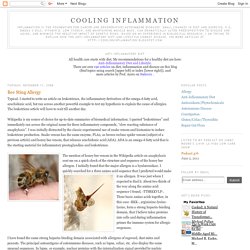
I started to write an article on leukotrienes, the inflammatory derivatives of the omega-6 fatty acid, arachidonic acid, but ran across another powerful example to test my hypothesis to explain the cause of allergies. The leukotriene article will have to wait till another day. Wikipedia is my source of choice for up-to-date summaries of biomedical information. I queried “leukotrienes” and immediately ran across the original name for these inflammatory compounds, “slow reacting substance of anaphylaxis”. I was initially distracted by the classic experimental use of snake venom and histamine to induce leukotriene production. The mention of honey bee venom in the Wikipedia article on anaphylaxis sent me on a quick check of the structure and sequence of the honey bee allergen.
It was just where I expected to find it. I have found the same strong heparin-binding domain associated with allergens of ragweed, dust mites and peanuts. 14 Signs of Nightshade Sensitivity (and What to Do About It) Non-celiac gluten sensitivity: people without celiac disease avoiding gluten-is it due to histamine intolerance? - PubMed - NCBI. The Wine Allergy Puzzle - Vinami. Cooling Inflammation: Peanut Allergy Cause and Cure. Summary: The cure for peanut allergy should follow naturally from knowledge of the cause.
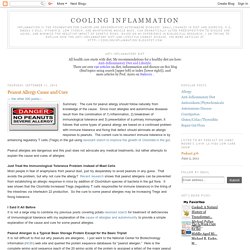
Since most allergies and autoimmune diseases result from the combination of 1) inflammation, 2) breakdown of immunological tolerance and 3) presentation of a primary immunogen, it follows that some types of peanut allergy are based on a continued problem with immune tolerance and fixing that defect should eliminate an allergic response to peanuts. The current cure to resurrect immune tolerance is by enhancing regulatory T cells (Tregs) in the gut using resistant starch to improve the growth of Clostridia in the gut. Reducing Peanut Allergy + Peanut Butter Alternatives.
In the U.S., approximately 1 to 2 percent (or more) of the population has a peanut allergy — about 3 million people — a percentage that continues to rise.

For instance, in the past two decades, the prevalence of peanut allergies has more than quadrupled, up from 0.4 percent of the U.S. population in 1997 to 1.4 percent in 2008 to more than 2 percent in 2010. (1) Peanut allergies are more prevalent among children under 3 years old, and the risk of developing a peanut allergy increases to 7 percent for a sibling of a child with a peanut allergy. (2) It’s why peanuts are among the “big eight” food allergies, along with eggs, fish, milk, tree nuts, shellfish, soy and wheat.
What’s really disturbing is that there’s no clear, definitive reason why this common food allergy is on the rise, but new research in the New England Journal of Medicine suggests that avoiding peanuts at an early age may be partly to blame. What Is a Peanut? Egg Allergy & Intolerance + Healthy Egg Alternatives. Could you have an egg allergy or egg intolerance?
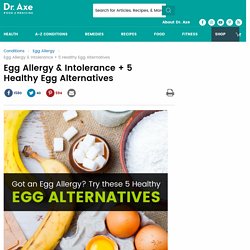
By themselves, eggs are a popular protein source at the heart of many healthy and tasty meals. They’re also a key ingredient in many popular food items like pasta, pancakes and so many more. Salicylate Sensitivity: Causes, Symptoms and Foods to Avoid.